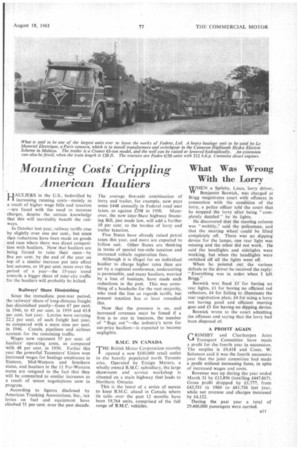Mounting Costs' Crippling American Hauliers
Page 45

If you've noticed an error in this article please click here to report it so we can fix it.
HAULIERS in the U.S„ bedevilled by increasing running costs—mainly as a result of higher wage bills and taxation —are faced with the need to increase charges, despite the certain knowledge that this will inevitably benefit the railways.
In October last year, railway tariffs rose by slightly over one per cent., but since then reductions have been made on goods and runs where there was direct competition with hauliers. Now that hauliers are being forced to raise their rates—by five per cent, by the end of the year on top of a similar increase put into effect last autumn, or 10 per cent. more over the period of a year—the 15-year trend towards a bigger share of inter-city traffic for the hauliers will probably be halted.
Railways' Share Diminishing Since the immediate post-war period,' the railways' share of long-distance freight has diminished yearly—from 67 per cent. in 1946, to 45 per cent. in 1959 and 43.8 per cent. last year. Lorries were carrying 22.2 per cent, of such freight last year, as compared with a mere nine per cent. in 1946. Canals, pipelines and airlines account for the remaining traffic: Wages now represent 55 per cent. of hauliers' operating costs, as compared with 48 per cent. in 1950, Earlier this year the powerful Teamsters' Union won increased wages for haulage employees in Eastern, Mid-Western and Southern states, and hauliers in the 11 Far-Western states are resigned to the fact that they will be committed to similar increases as a result of union negotiations now in progress.
According to figures disclosed by American Trucking Associations, Inc., tax levies on fuel and equipment have climbed 51 per cent, over the past decade. The average five-axle -combination of lorry and trailer, for example, now pays some £448 annually in Federal road user
taxes, as against £298 in 1950. Moreover, the new inter-State highway financing Bill, just made law, will add a further 10 per cent, to the burden of lorry and trailer taxation.
Five States have already raised petrol taxes this year, and more are expected to follow suit. Other States are thinking in terms of special ton-mile taxation and increased vehicle registration fees.
Although it is illegal for an individual haulier to charge higher rates than are set by a regional conference, undercutting is permissible, and many hauliers, worried by a loss of business, have made such reductions in the past. This was something of a headache for the vast majority, who toed the line as regards tariffs, but present taxation has at least remedied this.
Now that the pressure is on, and increased revenues must be found if a firm is to stay in business, the number of "flags out "—the industry's term for cut-price hauliers—is expected to become negligible.
B.M.C. IN CANADA
THE British Motor Corporation recently opened a new $100,000 retail outlet in the heavily populated north Toronto area. Operated by Ensign Motors, a wholly owned B.M.C. subsidiary, the large showroom and service workshop is situated on a main highway that leads to Northern Ontario.
This is the latest of a series of moves to keep B.M.C. ahead in Canada where its sales over the past 12 months have been 19,764 units, comprised of the full range of B.M.C. vehicles.




















































































































